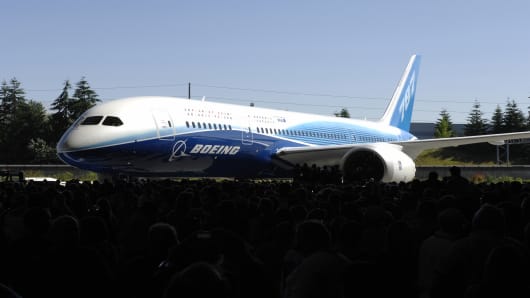Boeing said its fourth-quarter profit rose a greater-than-expected 4 percent, but it cut its full-year revenue forecast to account for delays on its new 787 Dreamliner.
The Chicago-based company, whose new carbon-composite, widebody plane is running about nine months late, raised its full-year earnings forecast, citing productivity gains, but left it short of Wall Street's average estimate.
Its shares, which have fallen 25 percent since last July on concerns about the 787, fell 0.3 percent to $80.70 in early trade on the New York Stock Exchange.
Boeing said it was on target to meet the revised production schedule set earlier this month, but did not mention when power would be switched on in the first 787, or project a schedule for deliveries beyond the first one in early 2009.
"There's no further elucidation on the interim milestones (on the 787)," said analyst Paul Nisbet at JSA Research. "That was noticeably absent."
The world's largest plane-maker by sales, which is also the Pentagon's No. 2 supplier, reported quarterly profit of $1.03 billion, or $1.36 per share, compared with $989 million, or $1.29 per share, in the year-ago quarter.
That beat Wall Street's average forecast of $1.32 per share, according to Reuters Estimates.
Sales were essentially flat at $17.5 billion as higher commercial plane sales were offset by lower revenue from its defense unit, due to fewer military plane deliveries and moving its government satellite launch business into a separate joint venture. It still beat analysts' average estimate of $17.2 billion.
Raises Outlook
Boeing, which outsold rival Airbus last year in the commercial plane market, raised its full-year profit forecast to a range of $5.70 to $5.85 per share, from its previous forecast of $5.55 to $5.75 per share, citing higher expected commercial plane deliveries and productivity gains.
Wall Street is expecting $5.95 per share, on average. It cut its full-year revenue forecast by $500 million, to a range of $67 billion to $68 billion, due to first deliveries of the 787 being pushed into 2009.
Work on the 787 is sticking to its new schedule, Boeing said. Production of the hot-selling, fuel-efficient plane has been hobbled by unfinished work from its network of global suppliers and a shortage of key parts.
The first plane is now set to be delivered early next year, rather than the original target of May this year.
Despite early production problems, Boeing's 787 is the company's most successful launch. The aircraft, which promises to cut airlines' fuel bills and give passengers a smoother ride, has racked up more than 800 firm orders since launch in 2004.
Boeing said Wednesday it "continues to address challenges associated with assembly of the first (787) airplanes" but expects the first test flight around the end of June and the first delivery in early 2009.
Record Orders Last Year
The U.S. plane maker booked an industry-record 1,413 net plane orders in 2007, beating Airbus' 1,341. That made for the industry's most successful year on record, with more than 2,750 orders between them, driven by a sustained resurgence in travel that has fueled demand for jets, particularly in the Middle East and Asia.
Boeing's commercial airplanes unit posted a 17 percent increase on fourth-quarter revenue to $8.9 billion, driven by a 9 percent increase in airplane deliveries and higher services revenue.
Boeing delivered 112 commercial planes in the quarter, up from 103 in the same quarter last year. For all of 2007, it delivered 441 planes, compared with 453 for Airbus. Wall Street analysts pay special attention to plane deliveries as that is when the companies get the bulk of their payments for planes.
Boeing said it is now expecting to deliver between 475 to 480 planes this year, down from its previous estimate of 480 to 490, due to the delay on the 787 program.
The company's Integrated Defense Systems unit, which is the U.S. No. 2 contractor behind Lockheed Martin posted a 14 percent drop in fourth-quarter revenue to $8.4 billion, because of lower military plane deliveries and the shifting of some government satellite launch revenue into a joint venture with Lockheed Martin.


